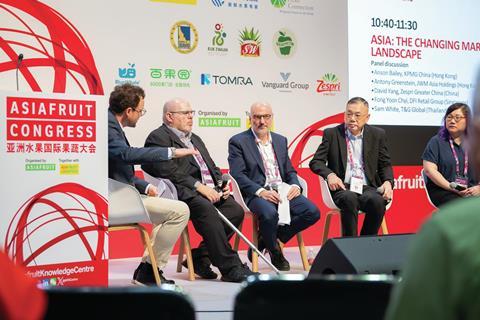Despite the challenging economic climate in Asia, market opportunities abound for fresh produce brands if they can better understand and target consumers
Economies across Asia have been facing headwinds of late, with consumers battling inflation and cost-of-living pressures. The opening panel discussion at this year’s Asiafruit Congress on 3 September explored the impact on shopper behaviour and looked at the broader opportunities to grow fresh produce sales in Asia’s fast-evolving consumer markets.

Antony Greenstein, CEO of leading pan-Asia distributor Joy Wing Mau Asia, said the economic data coming out of the region did not reflect the on-the-ground realities for the fresh produce business.
“The general figures on GDP growth point to around 4.9 per cent for Asia. The forecasts optimistically predict this to trend upwards, and for inflation to come down from 5 per cent to around 2.5 per cent. But it’s a different story in terms of what’s going on in the market,” said Greenstein.
“In Asia, most people we talk to are saying the Covid initiatives and stimulus has washed out of the system. Inflation has basically eroded disposable income and weakened consumer confidence.
“We know in China, there are personal savings, but the middle class is not buying as much as they used to. We’re taking measures to deal with the economic fallout that we expect over the next couple of years. We’re looking at our workforce and our supply chain and how we can achieve more efficiency.”
China remains the driving force of the fruit business in Asia, and the nation is “moving into a new economic reality”, according to David Yang, Zespri’s head of market development for Greater China.
Looking at the fresh fruit market in China, Yang said overall volume sales declined by 1.2 per cent in 2023, while value declined 3.7 per cent. However, sales of premium fruits were up 8 per cent in volume terms, fuelled by durian, cherries, blueberries and kiwifruit.
Fresh fruit sales for 2024 in the year to date have failed to produce a turnaround. Overall consumption is down 7.9 per cent, with value falling 6.6 per cent and volume slipping 1.3 per cent, Yang noted. Again, sales of premium fruits bucked the trend, but the rate of growth reduced from 8 per cent to 2 per cent, while the prices dropped significantly.
“Durian volume sales have grown by 11 per cent, but prices actually dropped by 17 per cent. Sales of blueberries grew by 25 per cent but the price fell by 11 per cent,” said Yang. “So we foresee the growth of the fruit market being driven by premium categories. But the growth will come at reduced prices.
“People are not seeking out produce with the lowest prices though; they want good value and consistent quality. As long as you can demonstrate your brand presents good value, you’ve still got a market.”
Value over price
Value over price is a trend observed across other markets in Asia. Fong Yoon Chyi, category director of produce for DFI Retail Group, which operates the Giant and Cold Storage supermarket banners in Singapore, said the definition of value had been redefined.
“In the past, consumers saw value as all about being cheap, but they’re more discerning nowadays. It’s not about being cheapest; it’s about having good quality products. There are different segments of consumers, so as a retailer we have a wide range of products for customers to choose from catering to all needs.”
In Thailand, the market for higher value imported fruits such as Envy apples also continues to grow despite tougher economic conditions, according to Sam White, T&G Global’s Thailand country manager. “Consumers are willing to open their wallets if you can give them a guarantee they’re going to have a great experience,” he said.

Despite the economic challenges facing China, Yang also highlighted the untapped growth potential in the consumer market for leading fruit brands like Zespri.
“In the past, our business concentrated on the top-tier cities: the top 20 or 30 tier-one and tier-two cities. Together they have a population of around 320m,” he said. “Another 80m middle class consumers are coming up in the next eight to ten years, but 70 per cent of the newly generated middle class will come from lower tier cities. We need to look into how we can penetrate this market more effectively.”
So how do fruit marketers effectively reach consumers, especially in such a diverse and dynamic retail market as China’s?
“In China, the neighbourhood stores and small supermarkets specialising in fresh are taking share away from the big chains,” said Yang. “E-commerce was taking share away from brick-and-mortar, and the livestream channels like TikTok are taking share away from e-commerce. Brick-and-mortar is now winning share back from e-commerce through offline to online. So you have to understand your consumer in these channels and target them with the most effective strategies. You have to build skills within your team and partner with the right distributors and retailers.”
Health trends
Health and wellness is a growing trend among consumers in Asia, and one that presents untapped opportunities for fresh produce marketers. While T&G’s marketing of the Envy apple has focused on its premium positioning, White said targeting the snacking market would become more important in the future.
“You’ve got to balance the health and wellness message with the premiumness, the taste and all those other things that bring your consumers to the table,” he said. “But I do see the future of Envy as a convenient snacking option where we can reach those younger consumers that are hard to reach with fruit. That breaks us out of the fruit category into the much bigger category of snacking.”
Anson Bailey, Asia-Pacific head of consumer and retail practice at KMPG, urged the fruit business to seize the initiative from FMCG. “FMCG is miles ahead in its consumer marketing,” said Bailey. “The fruit business needs to turn the tables on them and say ‘there are huge health and wellness benefits to our products, much more than those FMCG products’.

“Consumers have so many touchpoints on data, so it’s about collecting that data and using it effectively and forging strategic collaborations with retailers.”
While acknowledging the fruit business is behind FMCG, Greenstein pointed out it is dealing with a lot more volatility in the supply chain, not least given the impacts of climate change. Nevertheless, he noted there are structural issues for the industry to overcome to service the consumer effectively.
“I’ve had a premise for 25 years that the supply chain in this business is often very convoluted and complicated and that we don’t really know who our customers are. When we go and see our farmers, we feel they’re the customer but they’re not really.
“Our responsibility is to get the whole supply chain to service the end consumer and make sure we’re giving them the best value product by getting the supply chain properly aligned. There’s a lot of erosion of value by not getting the supply right. We lose opportunities by having the wrong fruit in the wrong market. We need to take the trading element out of the business and build more collaboration and transparency.”
The challenge of understanding the consumer is not aided by the fact market research agencies do not traditionally track shopper behaviour for fresh fruit in Asia, White noted.
“We can’t just go and buy this data off the shelf, so we’re looking at innovative ways we can develop that information, how we can get it ourselves,” he said. “That’s what we really need to bring to our retail partners.”



